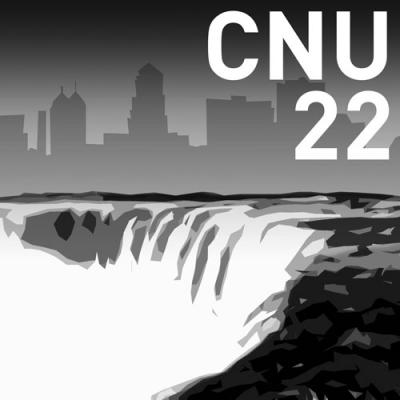Considering the City: CNU 22
The Results of the Congress for New Urbanism Conference and what Erie could stand to learn from it.
The Congress for New Urbanism (CNU) advocates "traditional neighborhood design." At this twenty-second annual conference (CMU 22), Civitas learned more about urban waterfront development and form-based zoning – ideas that could benefit Erie.
Regarding the waterfront: a century ago, John Nolen, (one of the great-grandfathers of CNU) commented that Erie's "great harbor is naturally the finest for commerce on the Great Lakes." But, water transportation has long been outpaced by railroads, interstates, and airports.
However, CNU speaker James Howard Kunstler (author of The Long Emergency) says we are experiencing the "end of cheap oil" and that our economy will become dependent on "inland waterways." This is a wake-up call for Erie to beef up docks and establish water transit to cities on the Great Lakes.
Erie's bluff discourages pedestrian and bike access to the water; most people drive to the Bayfront. Back in 1913, Nolen suggested pedestrian piers spanning over the railroad tracks (today's highway.) Another idea was to cut through the bluffs – as has been done at State and Holland streets.
Taking a cue from Nolen (and from Dan Dahlkemper's and Lisa Austin's collaborative proposal for Cleveland's "Irishtown Bend") Civitas suggested a diagonal grid of pathways, plazas and staircases from Liberty and Parade streets. Before his untimely death on June 3, Jeff Gault, the founder of BABO (Bayfront Access and Beautification Organization), reported that a pedestrian path will be established on the bluff this year with a crossing to Liberty Park. While welcome, a street-based connection would better help revitalize bluff-top neighborhoods.
CNU speaker John O. Norquist, who served as Milwaukee's mayor during that Great Lake city's dramatic revitalization, said that communities that "want their waterfronts to come alive" should create "small cafes, bars, and retail outlets to reflect the people and the culture."
Erie's waterfront has worthy, but isolated destinations including the Intermodal Center, the Blasco Library, the Maritime Museum, the Bicentennial Tower, the Sheraton, the Bayfront Convention Center, a miniature golf course, several restaurants, parks, private clubs, a nursing-home, and gated-residences – but, we need more small, varied, and walkable developments.
Another CNU speaker, the celebrated urban planning policy consultant and former mayor, Enrique Peñalosa, helped transform one of the world's most dangerous cities: Bogata, Columbia. Peñalosa improved public transportation and public parks to create "good pedestrian space." He promoted the right of all residents "not just to survive, but to be happy" and to "not feel inferior."
Peñalosa said that "great cities" find ways to put "very wealthy people next to very low-income people together as equals" in public spaces. Given Erie's rise in crime, perhaps it is time to study Bogata's success.
Closer to home, Buffalo's mayor offered a path to zoning reform. In 2010, Mayor Byron Brown "tossed out" the city's 1950's-era zoning ordinance and created a "Green Code" based on New Urbanist principles of "smart-growth." Buffalo's new form-based zoning guides a building's façade and volume and is concerned with each building's relationship to other buildings and to sidewalks and streets. "Green Code" regulations encourage mixed-use, walkable neighborhoods by jointly regulating private and public space and by eliminating minimum parking requirements in favor of "standards on the form, location and environmental performance" of parking.
In contrast, Erie's zoning focuses on parking requirements and the use of the site: single-family homes here, multi-family housing there, and a push for shopping, office, and industrial structures somewhere else.
While Erie's zoning ordinance has good features, the Zoning Hearing Board (ZHB) frequently overturns the code, weakening its power to shape our community. For instance, the Erie County Historical Society (ECHS) requested a variance to construct a parking lot and a single-story collections warehouse "behind" the society's Watson-Curtze Mansion. Even though the neighboring structures are multi-story residential buildings located the same distance from the street, the ZHB granted the ECHS request. Sadly, the character of this historic West Fifth Street residential neighborhood will be permanently altered by the ECHS parking lot and warehouse.
Another unfortunate example: the GetGo corporation bought an industrial site on the Bayfront and West 12th Street and then asked permission to break the zoning rules to build a gas station, food center, and car wash. Again, the ZHB said "yes." The handsome, ivy-covered, Reed manufacturing building on the Bayfront and West Eighth Street is an appropriate industrial structure. The entrance to our waterfront will be soon be marred by another brightly-lit, 24-hour "pole-barn."
Erie deserves better.
And Erie leaders are trying. Already, the work of BABO, the Sons of Lake Erie, the Lake Erie Regional Conservancy, and others echo Peñalosa's ideas about public space. Brenda Sandberg, the Director of Erie's Department of Economic and Community Development, reports that during 2004 to 2005, Erie rewrote its Zoning Code and took "baby steps" towards form-based zoning in residential neighborhoods. With luck, the Destination Erie report will encourage Erie to adopt a CNU-inspired form-based zoning and hire a City Planner with the power to advocate for public spaces.
Erie's 1913 City Planning Committee – the one that hired Nolen – wrote that Erie "faces a promising future" and that "the task of today is to solve present problems and to plan wisely and unselfishly." In 2014, Erie's vast potential remains, as does the "the task" of planning "wisely and unselfishly."
Join the conversation during a Preservation Happy Hour co-hosted by City Councilman Dave Brennan and Civitas at the Plymouth Tavern at 5:30 p.m., on Thursday, July 24.
Civitas members can be reached at their website www.civitaserie.com, via Facebook at CivitasErie, by emailing Lisa@civitaserie.com, or by scheduling a Friday morning meeting at the Civitas office in the Masonic Building, 32 W. Eighth Street.


.png)
